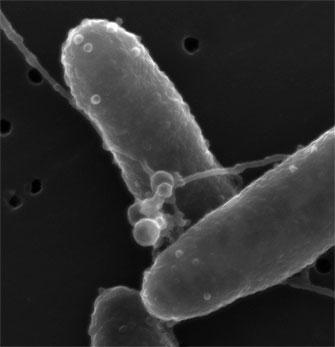| Posted: Oct 11, 2010 |
|
Microbial hair: It's electric
|
|
(Nanowerk News) Some bacteria grow electrical hair that lets them link up in big biological circuits, according to a University of Southern California biophysicist and his collaborators.
|
|
The finding suggests that microbial colonies may survive, communicate and share energy in part through electrically conducting hairs known as bacterial nanowires.
|
|
"This is the first measurement of electron transport along biological nanowires produced by bacteria," said Mohamed El-Naggar, assistant professor of physics and astronomy at the USC College of Letters, Arts and Sciences.
|
|
El-Naggar was the lead author of a study appearing online next week in Proceedings of the National Academy of Sciences.
|
 |
| Like human hair, a bacterial nanowire consists mostly of protein.
|
|
Knowing how microbial communities thrive is the first step in finding ways to destroy harmful colonies, such as biofilms on teeth. Biofilms have proven highly resistant to antibiotics.
|
|
The same knowledge could help to promote useful colonies, such as those in bacterial fuel cells under development at USC and other institutions.
|
|
"The flow of electrons in various directions is intimately tied to the metabolic status of different parts of the biofilm," El-Naggar said. "Bacterial nanowires can provide the necessary links … for the survival of a microbial circuit."
|
|
A bacterial nanowire looks like a long hair sticking out of a microbe's body. Like human hair, it consists mostly of protein.
|
|
To test the conductivity of nanowires, the researchers grew cultures of Shewanella oneidensis MR-1, a microbe previously discovered by co-author Kenneth Nealson, Wrigley Professor of Geobiology at USC College.
|
|
Shewanella tend to make nanowires in times of scarcity. By manipulating growing conditions, the researchers produced bacteria with plentiful nanowires.
|
|
The bacteria then were deposited on a surface dotted with microscopic electrodes. When a nanowire fell across two electrodes, it closed the circuit, enabling a flow of measurable current. The conductivity was similar to that of a semiconductor – modest but significant.
|
|
When the researchers cut the nanowire, the flow of current stopped.
|
|
Previous studies showed that electrons could move across a nanowire, which did not prove that nanowires conducted electrons along their length.
|
|
El-Naggar's group is the first to carry out this technically difficult but more telling experiment.
|
|
Electricity carried on nanowires may be a lifeline. Bacteria respire by losing electrons to an acceptor – for Shewanella, a metal such as iron. (Breathing is a special case: Humans respire by giving up electrons to oxygen, one of the most powerful electron acceptors.)
|
|
Nealson said of Shewanella: "If you don't give it an electron acceptor, it dies. It dies pretty rapidly."
|
|
|
|
In some cases, a nanowire may be a microbe's only means of dumping electrons.
|
|
When an electron acceptor is scarce nearby, nanowires may help bacteria to support each other and extend their collective reach to distant sources.
|
|
The researchers noted that Shewanella attach to electron acceptors as well as to each other, forming a colony in which every member should be able to respire through a chain of nanowires.
|
|
"This would be basically a community response to transfer electrons," El-Naggar explained. "It would be a form of cooperative breathing."
|
|
El-Naggar and his team are among the pioneers in a young discipline. The term "bacterial nanowire" was coined in 2006. Fewer than 10 studies on the subject have been published, according to co-author Yuri Gorby of The J. Craig Venter Institute in San Diego, discoverer of nanowires in Shewanella.
|
|
Gorby and others became interested in nanowires when they noticed that reduction of metals appeared to be occurring around the filaments. Since reduction requires the transfer of electrons to a metal, the researchers suspected that the filaments were carrying a current.
|
|
Nanowires also have been proposed as conductive pathways in several diverse microbes.
|
|
"The current hypothesis is that bacterial nanowires are in fact widespread in the microbial world," El-Naggar said.
|
|
Some have suggested that nanowires may help bacteria to communicate as well as to respire.
|
|
Bacterial colonies are known to share information through the slow diffusion of signaling molecules. Nealson argued that electron transport over nanowires would be faster and preferable for bacteria.
|
|
"You want the telegraph, you don't want smoke signals," he said.
|
|
Bacteria's communal strategy for survival may hold lessons for higher life forms.
|
|
In an op-ed published in Wired in 2009, Gorby wrote: "Understanding the strategies for efficient energy distribution and communication in the oldest organisms on the planet may serve as useful analogies of sustainability within our own species."
|

